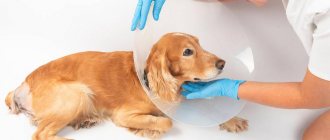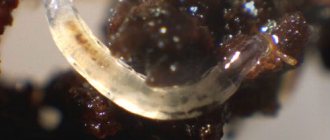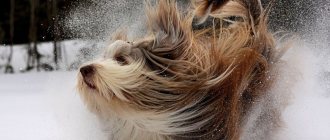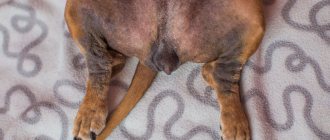Dog owners quite often encounter changes in the color intensity (pigmentation) of the nose. This includes lightening of areas or the entire lobe during the puppy’s growth, a “winter nose” during the cold season, and disruption of the coloration of the nose after infectious diseases or chronic problems with the gastrointestinal tract, etc. And if the owners of ordinary pets consider this a purely cosmetic problem and are sometimes touched by the pink spots of their pets, then for show dogs everything is much more serious. An animal with impaired pigmentation of the nose is in most cases criticized by experts, and it is rare that a judge at an exhibition gives a high rating even to a dog that is ideal in all other respects.
We will not consider such a quick, but not entirely correct way to eliminate this problem as a special camouflage marker for the nose, which paints over problem areas during the exhibition; there are much more effective and proven ways to enhance pigmentation of the nose in dogs.
Physiology of the nose in dogs
Normally, the nose of a healthy dog is jet black (with the exception of some breeds, which allow the nose to be colored to match the color of the coat and albinism). The color of the nose is determined by the content of melanin pigment in special skin cells (melanocytes), which is formed as a result of the oxidative transformation of the amino acid L-tyrosine. It is because of the decrease in this pigment in melanocytes that the color of the nose begins to change - it becomes lighter, browner, and in severe cases even turns pink.
Ranosan
Combined ointment for animals developed by Apicenna. The drug contains 4 components that have a complex therapeutic effect:
- Dioxidin is antimicrobial.
- Chloramphenicol (chloramphenicol) – antibacterial.
- Methyluracil is a wound healing agent.
- Lidocaine is an anesthetic.
Apply the ointment evenly with a spatula or gauze pad once a day. Treatment period is up to 14 days.
According to reviews from owners, Ranosan quickly heals open wounds, postoperative sutures, copes with purulent, long-term non-healing injuries, and inflammatory skin lesions. Well tolerated by dogs and does not cause side effects.
Ranosan is available in veterinary pharmacies in powder form. The price of the drug is from 130 rubles.
Causes of depigmentation of the nose
Dogs, even with heavily depigmented noses, often look healthy and active. Only after a comprehensive examination is it possible to identify one or more problems that should be paid close attention to, since they can cause metabolic disorders in the body and, in particular, a decrease in the melanin saturation of pigment cells.
The most common causes of nasal lightening are:
- liver dysfunction, chronic pancreatitis
- chronic diseases of the gastrointestinal tract
- hormonal imbalances
- errors in feeding (unbalanced diet with an excess content of easily digestible carbohydrates and insufficiency of complete proteins, which leads to a deficiency of amino acids - pigment precursors)
- developing malignant processes due to a decrease in the animal’s immune status
- hypovitaminosis.
Possible complications
If pigmentation is genetically based, the condition of the spots should be monitored. If a red halo (a sign of inflammation) appears around them, you should consult a doctor.
Self-medication is unacceptable. A dangerous infection can develop in a dog’s body, and assistance provided untimely will require either long-term severe treatment or will not be able to overcome the advanced form of the disease.
Classification of depigmentation
Veterinary specialists distinguish the following types of depigmentation of the nose:
- Idiopathic, depending on the individual characteristics of the dog, the causes of such depigmentation are very difficult and often impossible to establish
- Seasonal (best known as “snow nose”, when the nose, normally pigmented in summer, becomes discolored in winter. Although many experts are inclined to the opposite opinion, believing that the initially weakly pigmented nose in the summer simply tans and darkens due to increased production melanin under the influence of sunlight)
- Inflammatory (occurs as a result of inflammatory processes in the animal’s nose)
- Allergic (for allergic reactions to dishes, toys, food)
- Hormonal (due to disruption of the synthesis and interaction of hormones (pituitary gland, thyroid gland, sex hormones) involved in the synthesis of melanin)
- Thermal (arising as a result of frostbite or, conversely, sunburn)
- Traumatic (disturbance of pigmentation at the site of wounds, scratches, scars)
- Nutritional (due to lack of essential vitamins and minerals in the diet)
- Autoimmune (vitiligo and some other diseases)
- Genetic (inherited).
Household factors
In some cases, everyday causes can also cause nasal hypopigmentation in an animal. What can be attributed to such factors?
Dry air
Dry air in a living space is a very common story. This problem is especially typical in the winter, when heating radiators are “scalding to the fullest.” Not only pets, but also people suffer from this. The skin becomes dry and peeling appears. The four-legged fur dries and becomes brittle. In addition to loss of pigment, the nose may also become dry and cracked. To prevent this from happening, ventilate your home regularly. However, while one room is being ventilated, it is better for all household members to stay in another. Otherwise, cold air and drafts can cause colds in both people and pets.
I always ventilate the apartment when Jack and I go for a walk.
Allergic reactions
Often, incorrectly selected household items can cause allergic reactions, which in turn manifest themselves in the form of irritation of the mucous membranes, dermatitis, hair loss, and so on. An incorrectly selected shampoo or things that the animal is constantly in contact with can cause discoloration and peeling of the nose, the appearance of bald patches and wounds on the skin.
Thus, some plastic or rubber products, such as plastic food bowls, contain melamine. It is the main component for making plastic. Thanks to it, plastic products do not break and are heat resistant. But not everyone knows that upon contact with food and liquids, plastic releases formaldehyde, which is very dangerous and harmful to both animals and humans. Long-term use of such dishes can cause allergic reactions, skin diseases, inflammation of the mucous membranes of the nasolabial part, impaired pigmentation of the dog’s lips and nose, tumors and poisoning.
Therefore, first of all, you need to find out what your pet is allergic to, and then eliminate its cause. And if you use plastic bowls to feed your pet, then they should definitely be replaced with metal ones.
Diagnostics
There are many causes and types of depigmentation of the nose in dogs, so treatment prescribed only after examining and recording the external condition of the animal is often ineffective. The veterinarian should, at a minimum, do a detailed blood test, if necessary, take scrapings from discolored areas of the nose and their microscopy, cultures for fungi and bacterial flora, and allergy tests.
But even a comprehensive examination does not always reveal the reason for the lightening of a dog’s nose. Therefore, if there are no serious health problems, veterinarians prescribe measures aimed at providing the body with the necessary nutrients that promote the production of melanin. In most cases, this is enough, and changing the diet and introducing additional vitamins and microelements can eliminate nasal depigmentation.
Pathologies and diseases
A sudden and causeless change in color may indicate the presence of a disease. As a rule, this circumstance is accompanied by other symptoms.
Bacterial infections
A four-legged friend can become infected with a bacterial infection either through contact with other animals or through airborne droplets. At risk are dogs whose living conditions cannot be called positive. Associated symptoms are loss of appetite or partial refusal of food, weight loss, fever, lethargy and drowsiness.
Neoplasms and tumors
Oncology can also lead to lightening of the lobe.
Lupus
The disease is expressed in unusual behavior of the immune system, which attacks the cells and tissues of its own body. Most often, the disease manifests itself after the pet reaches the age of 6 years, when the lobe begins to turn white.
Pemphigus
The type of the disease is similar to lupus. The cause of the disease is infectious diseases, exposure to ultraviolet radiation, and excessive use of medications.
Vitiligo
The disease is a violation of the production of melanin. Some breeds are prone to the disease: huskies, Labradors and dachshunds. The earlobe can not only lighten, but also turn pink; by the way, this is the most common answer to the question why a husky’s nose turns pink.
Dudley's nose
To this day, genetic pathology cannot be explained in veterinary medicine. Yellow Labradors are known to have the greatest tendency.
If a pathology is detected, it is necessary to take measures to cure it, and then the natural color will return very soon
Treatment of depigmentation of the nose
- If infectious, parasitic, inflammatory, or fungal diseases are discovered during diagnosis, then first of all they begin with their treatment. Hormonal and autoimmune problems require more careful investigation and longer treatment.
- In most cases, the pigmentation of the nose can be increased by balancing the dog's diet. Switching your animal to premium and super premium dry food allows you to provide your pet with all the necessary nutrients, which has a positive effect not only on the pigmentation of the nose, but also on its overall health.
- Taking courses of zinc and sulfur-containing drugs (these substances are involved in the synthesis of melanin, but the dosage and duration of use should be determined by a veterinarian) also has a beneficial effect.
- The use of drugs containing amino acids (Gamavit, Chiktonik, Calphostonik) can improve metabolism and melanin synthesis.
- Good results are achieved when using additives that include seaweed - Beaphar Algolith, Canina Seealgen.
- Salmon oil, which contains Omega-3 and 6 fatty acids, vitamins A and E, as well as iodine, is another unique drug that allows you to stabilize the thyroid gland, enhance pigmentation of the nose, and improve the condition of the skin and coat in general.
- Vitamin E is essential for maintaining healthy skin. When treating depigmentation of the nose, this vitamin must be prescribed without fail. Good results are achieved by lubricating the nose with sea buckthorn oil, which contains a large amount of tocopherols (vitamin E) and carotenoids (precursors of vitamin A).
- With hereditary depigmentation of the nose, which is determined genetically, other color defects often appear - white spots, light claws (this applies to those dog breeds in which such deviations are unacceptable). In this case, it is necessary not to mask the discolored nose on the eve of the exhibition using a special marker, hoping to obtain permission for breeding, but to cull such dogs from breeding.
The article was prepared by specialists from the online pet store “Zoomark” https://zoomark.com.ua
Levomekol
Antibacterial wound-healing ointment, available for both humans and animals, marked “vet”.
Medical and veterinary Levomekol are identical in composition and contain 2 active ingredients:
- Levomycytin - destroys pathogenic bacteria that cause skin infections.
- Methyluracil - improves cellular metabolism, accelerates healing, stimulates tissue regeneration, strengthens local immunity.
Levomekol is used to treat infected, purulent wounds. Treatments are repeated 1 – 2 times a day. The maximum treatment period is 10 days.
The healing components quickly penetrate the tissues, do not damage healthy cells, and retain their properties even in the presence of pus and blood. The price of a 100 g tube of Levomekol is about 100 rubles.
Trauma gel
Complex homeopathic preparation for animals against skin lesions.
Contains matrix tinctures of medicinal herbs, organic and mineral components with a pronounced therapeutic effect:
- anti-inflammatory;
- painkillers;
- regenerating;
- decongestant.
Injury gel is used to treat wounds, cuts, bites, abrasions on the skin, mucous membranes and paw pads, and postoperative sutures. The drug is applied to injured areas in the morning and evening. The duration of treatment for dogs is 5 – 10 days. Depending on the severity of the damage, the course can be extended. A jar of Trauma gel 20 ml costs from 180 rubles.











